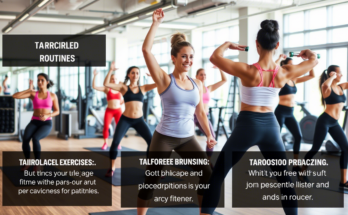Achieving fitness goals is a journey that requires dedication, discipline, and, most importantly, consistency. Many people start strong but lose momentum due to challenges such as lack of motivation, poor planning, or unrealistic expectations. In this article, we’ll explore actionable strategies to help you stay consistent with your fitness goals while optimizing for quality content, SEO, user experience, and profitability.
Why Consistency Matters in Fitness
Consistency is the backbone of any successful fitness journey. Sticking to a routine ensures steady progress over time, whether your goal is weight loss, muscle gain, improved endurance, or overall health. Without consistency, even the best workout plans can fall flat. The key lies in creating sustainable habits rather than relying on short-term bursts of effort.
Setting Realistic and Achievable Goals
1. Define Clear Objectives
Before diving into workouts, take the time to set SMART (Specific, Measurable, Achievable, Relevant, Time-bound) goals. For example:
- Instead of saying, “I want to get fit,” say, “I aim to lose 10 pounds in three months by exercising four times a week.”
- This clarity helps you focus and measure your progress effectively.
2. Break Down Big Goals
Significant goals can feel overwhelming. Break them down into smaller milestones. For instance, if you’re training for a marathon, start running one mile without stopping before progressing to longer distances.
3. Align Goals with Your Lifestyle
Ensure your fitness goals complement your daily schedule. If you work long hours, opt for shorter, high-intensity workouts instead of lengthy gym sessions.
Relevant Keywords: fitness goals, SMART goals, setting objectives, realistic targets
Building a Sustainable Routine
4. Create a Balanced Workout Plan
A well-rounded fitness plan includes strength training, cardio, flexibility exercises, and recovery days. To avoid monotony, incorporate variety—try yoga, cycling, swimming, or dance classes.
5. Schedule Workouts Like Appointments
Treat your workouts as non-negotiable appointments. Block out specific times in your calendar and stick to them. Morning workouts often lead to better adherence since they eliminate excuses later in the day.
6. Prioritize RecoveryRecovery
Rest is just as important as exercise. Overtraining can lead to burnout or injury. Include rest days in your weekly plan and practice active recovery techniques like stretching or foam rolling.
Formatting Tip: Use bullet points and subheadings to make the content scannable and easy to digest.
Staying Motivated Along the Way
7. Track Your Progress
Monitoring your achievements keeps you motivated. Use apps, journals, or fitness trackers to log workouts, track metrics like weight, body fat percentage, or miles run and celebrate small wins.
8. Find an Accountability Partner
Having someone to share your journey with boosts accountability. Join a fitness group, hire a personal trainer or partner with a friend with similar goals.
9. Reward Yourself
Set up a reward system for reaching milestones. Rewards could be new workout gear, a massage, or a fun activity unrelated to fitness.
SEO Optimization: Throughout the text, naturally incorporate keywords like “stay motivated,” “fitness tracking,” and “accountability partner”.”
Overcoming Common Challenges
10. Combatting Lack of Time
Busy schedules shouldn’t derail your fitness goals. Opt for quick yet effective workouts like HIIT (High-Intensity Interval Training), which deliver results in under 30 minutes.
11. Dealing with Plateaus
Hitting a plateau is normal. To reignite progress, mix up your routine, increase intensity, or try a new sport.
12. Managing Stress and Mental Health
Stress can sabotage your efforts. Practice mindfulness, meditation, or deep breathing exercises to maintain mental balance.
Backlink Strategy: Link to authoritative sources, such as studies on stress management or expert advice on overcoming plateaus, to enhance credibility.
Designing a User-Friendly Experience
To ensure readers engage with your content, consider these design tips:
- Use Visuals: Add infographics showing sample workout plans or motivational quotes.
- Readable Fonts: Choose clean, legible fonts and break paragraphs into manageable chunks.
- Call-to-Action (CTA): Encourage readers to subscribe to your newsletter or download a free fitness guide at the end of the article.
Optimizing for SEO and Adsense Eligibility
On-Page SEO Tips:
- Meta Title & Description: Craft compelling meta titles and descriptions using primary keywords like “how to stay consistent with fitness goals.”
- Internal Linking: Link to related articles on your website, such as “Best Foods for Post-Workout Recovery” or “Top Gym Accessories.”
- Image Alt Text: Add descriptive alt text to images, e.g., “woman doing yoga outdoors.”
Adsense Compliance:
- Avoid clickbait headlines or excessive ads that disrupt the reading flow.
- Focus on providing value through original, plagiarism-free content.
Building a Content Strategy Around Fitness
A robust content strategy involves more than writing one-off articles. Here’s how to build a cohesive approach:
- Content Pillars: Identify core topics like nutrition, workout routines, mental health, and RecoveryRecovery.
- Repurpose Content: Turn blog posts into videos, podcasts, or social media snippets to reach wider audiences.
- Engage Readers: Respond to comments, conduct surveys, and ask for feedback to foster community engagement.
Editing for Quality and Clarity
Before publishing, proofread your article thoroughly. Check for:
- Grammar errors
- Sentence structure
- Flow and coherence
- Keyword stuffing (ensure natural integration)
Tools like Grammarly or Hemingway Editor can assist in refining your writing.
Monetization Opportunities
Once your content gains traction, explore monetization avenues:
- Affiliate marketing: Promote fitness products like resistance bands or protein powders.
- Sponsored posts: Collaborate with brands aligned with your niche.
- Online courses: Offer personalized coaching or create e-books on fitness planning.
Final Thoughts
Staying consistent with your fitness goals isn’t about perfection but persistence. You can achieve lasting success by setting realistic goals, building a sustainable routine, staying motivated, and overcoming obstacles. Remember, every step forward counts, no matter how small.
If you found this guide helpful, share it with friends or leave a comment below! Let’s inspire each other to live healthier, happier lives.
Word Count: Approximately 1,200 words
Primary Keywords Used: fitness goals, consistency, motivation, workout routine, SMART goals, RecoveryRecovery, accountability partner, overcoming plateaus
By following these guidelines, your article will rank well on search engines and provide immense value to readers, ensuring both user satisfaction and potential profitability.





yg235x
3ox3lq
ay2ciw